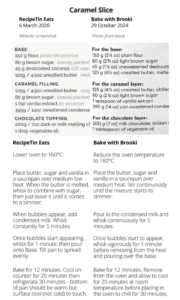Did Brooki Infringe RecipeTin Eats’ Copyrighted Recipes?
Earlier this May 2025, Nagi Maehashi, the popular Australian blogger behind RecipeTin Eats and author of the cookbook Tonight, won the illustrated book of the year, surpassing Brooke Bellamy, with whom she had been involved in a controversy.
Nagi alleges that Bellamy’s Bake With Brooki plagiarised her caramel slice and baklava recipe, but Brooke claims that she wrote and had been selling her recipe for 4 years. Since the issue has been raised, Maehashi and Penguin, Bellamy’s publishers, have engaged in legal representation, raising the question:
Could Bellamy be sued for plagiarising Maehashi’s recipe?
This question brings us to the copyright laws in Australia, outlined in the Copyright Act 1968, which protects a range of work such as texts, art, music and dramatic works. Maehashi’s recipes could be protected under copyright, since they are literary works and have been published in material form on her blog.
However, the controversy has been sparked by the question of whether and how recipes can be copyrighted. This is particularly given the nature of recipes themselves, where similarities in ingredients, quantities and steps are likely to occur, and often do.
Since the debate, cookbook authors have expressed how they are commonly inspired by each other’s recipes. This is likely why Australian patent law requires a high threshold in order for a recipe to be patented. In fact, section 50 of the Patents Act 1990 explicitly excludes inventions that are “capable of being used as food”, “mere mixtures of known ingredients”, and even processes producing these.
The recipe would have to involve some new, surprising or unexpected combination of ingredients or processes. Some examples include vegan meats or the preparation of cauliflower rice. A caramel slice or baklava recipe may not be patentable – but what about copyright?
The Copyright Act can only protect an expression of ideas, not the idea itself, for example, a caramel slice. This idea could include the ingredients, quantities, timing or methods used in its recipe. This is what allows others to use recipes to reproduce a dish or write their own description of the recipe.
However, if the written recipe were to be scanned, photocopied or translated, the copyright owner’s rights could be infringed. Infringement is also required to be in relation to a “substantial part” of the work, under section 14 of the Copyright Act. The 1994 case Milpurrurru v Indofurn provides guidance on what “substantial part” means, which can account for the volume of the original work, how much of it has been copied, the intention behind the infringement, and any competition between the works.
When comparing Maehashi and Bellamy’s caramel slice recipes, similarities are evident. Maehashi has also claimed originality as her recipe uses caramel, rather than golden syrup, in the base. However, it is important to remember that ingredients, their quantities, and steps are not protected. Also, infringements require the work in question to be almost exactly identical to the original.

Direct comparisons of RecipeTin Eats’ and Bake with Brooki’s caramel slice recipe. (RecipeTin Eats)
Finally, in addition to copyright, Maehashi’s recipes are protected by moral rights, including the right to be credited, and for her work not to be derogated. Accreditation is also considered a normative practice in the realm of recipe making and cookbooks, as creators are commonly inspired by each other.
Recipe makers recognise the importance and value of noting the background or sources used in their recipes. This is evident given the amount of backlash Bellamy has received since Maehashi has spoken up.
Whilst Maehashi has stopped further communication with Penguin’s lawyers and has not commenced any legal civil proceedings yet, this controversy showcases how maintaining an image in line with public expectations can often be just as important.

